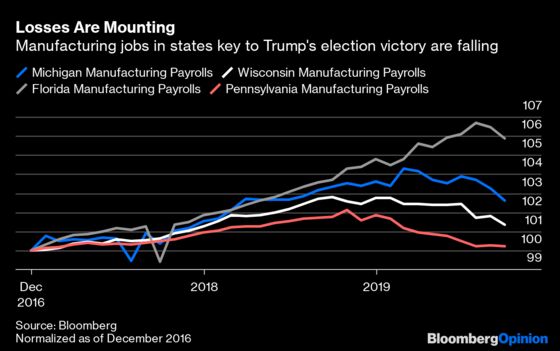(Bloomberg Opinion) -- The U.S. government Friday said the economy added 128,000 jobs in October, well above the 85,000 estimated by Wall Street and enough to prompt President Donald Trump to take to Twitter and call it a “blowout” number. As usual, though, the real news is in the details.
Not only did last month’s number of jobs created exceed expectations, but September was revised higher to 180,000 from 136,000. The problem, at least for Trump, is that employment in the manufacturing sector isn’t only weak overall, but actually declining in the four states that were key to his election victory in 2016: Wisconsin, Pennsylvania, Michigan and Florida.

The stock market reacted positively to the jobs report, with the S&P 500 Index setting another new high, not because of any extra jolt of confidence in the economic outlook. More likely, investors realized the lack of job growth in manufacturing only puts more pressure on Trump to reach a partial “phase one” trade deal with China, Medley Global Macro Managing Director Ben Emons wrote in a research note after the jobs report. Indeed, White House Economic Adviser Larry Kudlow told Bloomberg Television on Friday that the initial phase of a deal are close to completion.
The other thing the jobs report showed was the extent to which the pace of wage gains in manufacturing is starting to lag behind those in the service sector. Although the services make up a much larger part of the economy, salaries tend to be lower than in manufacturing.

The weakness in manufacturing was underscored by the latest read on the sector from the Institute for Supply Management, which followed the jobs report. The ISM’s benchmark factory index showed activity contracted for a third straight month, with the weakest production level since the last recession. The sense of urgency those kind of numbers put on reaching a trade deal is probably the reason stocks extended their gains.

Trump won the election in part by promising to deliver “victory” to factory workers by bringing production jobs back to the U.S. While manufacturing has added about half a million workers since Trump took office, those states that helped him win are now losing factory jobs amid the persistent trade war with China and a weaker global economy. And while jobs in the manufacturing sector were hurt last month by the strike at General Motors Co., employment in this part of the economy had been sliding even before September.
Commerce Department data show manufacturing made up 11% of gross domestic product in the second quarter, the smallest share in data going back to 1947, and down from about 25% in the 1960s, according to Bloomberg News’s Reade Pickert.
All else being equal, the jobs report shows the economy is still growing, albeit at a slower rate than in recent years. But the reality is that the labor market is a lagging indicator, with the unemployment rate reaching a cycle low at the start of every recession since at least 1970. And right now, it hasn’t been this low in half a century.
To contact the editor responsible for this story: Beth Williams at bewilliams@bloomberg.net
This column does not necessarily reflect the opinion of the editorial board or Bloomberg LP and its owners.
Robert Burgess is an editor for Bloomberg Opinion. He is the former global executive editor in charge of financial markets for Bloomberg News. As managing editor, he led the company’s news coverage of credit markets during the global financial crisis.
©2019 Bloomberg L.P.